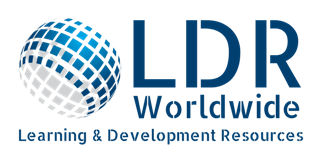The unique nature of LDR worldwide is our ability to provide our clients with a consistent solution that can be delivered across their footprint. We ensure that we are consistent in our methodology and objectives, yet localize the experience specific to the delivery site. LDR currently operates in 30 global locations with network capability and outreach to additional sites. LDR Worldwide is committed to following the footprint of our clients wherever they are in the world. LDR’s philosophy for design and delivery of training and development initiatives in global markets is to provide high quality training, consistent with Corporate Headquarters objectives in the language and culture of your business.
In Language
 Many US companies attempt to offer key training initiatives to their locations abroad with an expectation that their employees will be able to communicate effectively in English and, therefore, the training can be conducted in English. At LDR Worldwide we recognize that the best learning always happens in a learner’s native language. The physical and mental fatigue imposed upon the learner who is required to learn new concepts, translate them in their mind, apply them to their culture and translate back their interaction distracts from the core learning objectives. At LDR Worldwide, our goal is to help the learner be completely focused on learning so that we maximize the transfer of knowledge. To that end, our primary delivery model is to offer our training in the language of the majority of the learners participating in the experience.
Many US companies attempt to offer key training initiatives to their locations abroad with an expectation that their employees will be able to communicate effectively in English and, therefore, the training can be conducted in English. At LDR Worldwide we recognize that the best learning always happens in a learner’s native language. The physical and mental fatigue imposed upon the learner who is required to learn new concepts, translate them in their mind, apply them to their culture and translate back their interaction distracts from the core learning objectives. At LDR Worldwide, our goal is to help the learner be completely focused on learning so that we maximize the transfer of knowledge. To that end, our primary delivery model is to offer our training in the language of the majority of the learners participating in the experience.In Context
 Key-learning areas, such as management and leadership skills, are often contextual to the culture of US business practices and there is a reduction in knowledge transfer and behavioral modification when this is applied to other countries. In order for learners to move past knowledge to application of learning, the learning must be culturally relevant. As a result, LDR Worldwide is committed to knowing and understanding the cultural context of learners. If looking at an educational objective such as “Conflict Resolution” or “Team Work”, understanding the historical and cultural context, the class structure, gender roles or age related hierarchy may be critical for the knowledge to actually translate to behavior change. Our content designers work with our international team to assure cultural context is incorporated into the design of our learning initiatives.
Key-learning areas, such as management and leadership skills, are often contextual to the culture of US business practices and there is a reduction in knowledge transfer and behavioral modification when this is applied to other countries. In order for learners to move past knowledge to application of learning, the learning must be culturally relevant. As a result, LDR Worldwide is committed to knowing and understanding the cultural context of learners. If looking at an educational objective such as “Conflict Resolution” or “Team Work”, understanding the historical and cultural context, the class structure, gender roles or age related hierarchy may be critical for the knowledge to actually translate to behavior change. Our content designers work with our international team to assure cultural context is incorporated into the design of our learning initiatives.In Culture
 The delivery of training is best when the training is shared in the context in which it will be applied. This is especially true when working globally. Behaviours that may be appropriate on the job in one market may not be appropriate in another. A classic example is the cultural norm in Korean culture that a “junior” person would never correct their “senior” leader as this would be an act of greatest disrespect in Korean culture. Even in life and death situations, this norm is followed as was evidenced in the fact that Korean airline pilots would never challenge, correct or direct the senior pilot – even if it meant the plane would crash. As a result, Korean Airlines had one of the worst safety records in the industry. Until the training regarding speaking up or giving feedback could be placed in context, Western cultural norms did not apply to the workplace – none of the training efforts produced results. The results were only realized when the culture and context were brought together.
The delivery of training is best when the training is shared in the context in which it will be applied. This is especially true when working globally. Behaviours that may be appropriate on the job in one market may not be appropriate in another. A classic example is the cultural norm in Korean culture that a “junior” person would never correct their “senior” leader as this would be an act of greatest disrespect in Korean culture. Even in life and death situations, this norm is followed as was evidenced in the fact that Korean airline pilots would never challenge, correct or direct the senior pilot – even if it meant the plane would crash. As a result, Korean Airlines had one of the worst safety records in the industry. Until the training regarding speaking up or giving feedback could be placed in context, Western cultural norms did not apply to the workplace – none of the training efforts produced results. The results were only realized when the culture and context were brought together.
– from marketing Tipping Point- Malcolm Gladwell
